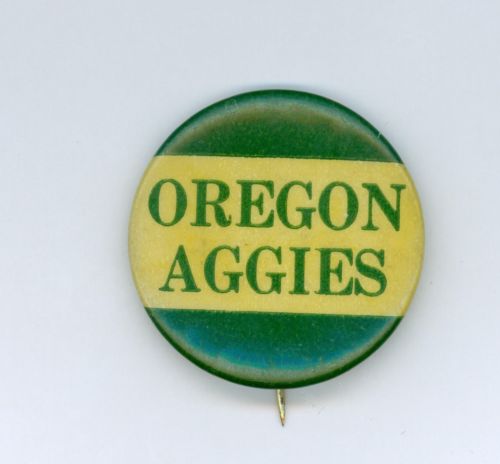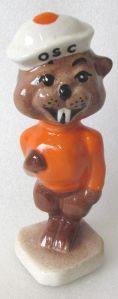This “Oregon Aggies” pinback is somewhat of a mystery to me for one simple reason… the colors are green and yellow instead of black and orange! I have seen two of these pins and both appeared to have been originally printed in these colors, as opposed to maybe the orange fading to a yellow and/or the black fading to a green tint. Very disturbing for an Oregon State fan!
As far as I know, Oregon State, or Oregon Agricultural College as it was known in the early 1900’s, was the only group/organization in Oregon to be referred to as the Oregon Aggies. I haven’t found reference to any other sports group or organizations who may have also been called the Oregon Aggies. I also know Oregon State was still referred to as the Aggies until at least 1926. While the school’s animal mascot had become the Beaver during the prior decade (at least on some pennants and in the yearbooks), I’m guessing the official “Aggies” name may have been dropped and the Beaver officially took over when the school changed names from Oregon Agricultural College (OAC) to Oregon State College (OSC) in 1927. These facts would seem to put the age of this pin, which is slightly smaller than normal pin – about the size of a half dollar, sometime in the late-teens-to-mid-1920’s.
Now as for the colors, Oregon State had officially adopted Orange and Black as its school colors by 1893. And their rivals to the south, the University of Oregon, had adopted green and yellow as their colors in 1894. So why would an Oregon State pin have been printed in green and yellow? Was it an early prank by the Ducks on their Beaver neighbors? Or was this perhaps tied to a topic I posted about earlier, where back in 1917, the “Rooks” (aka freshman) on campus were forced to wear green caps so they could be identified? After all, the 1917 “Rooks” poster was printed with green text, the caps were green… so I wonder if they could only wear green pins too? However, the letter on the green cap back then was orange and not yellow! So why the yellow? Because if there’s two colors we know Oregon State alumni and fans despise… it’s green and yellow! This may go down as one of OSU’s great mysteries!















